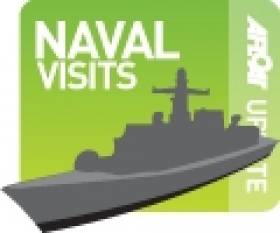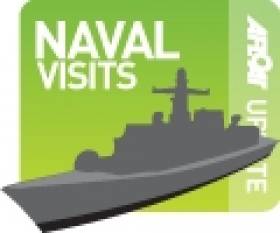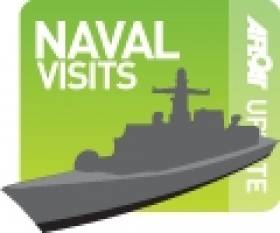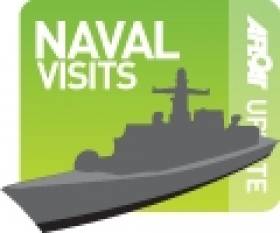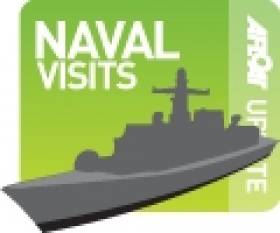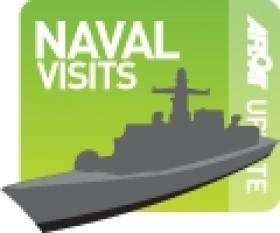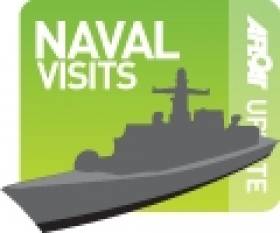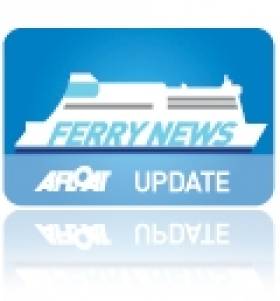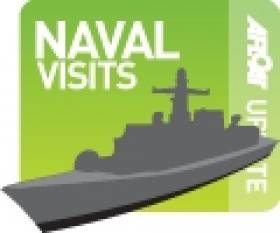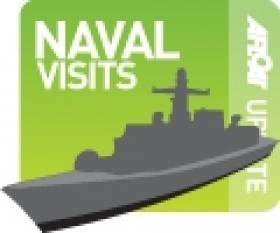Displaying items by tag: French Navy
French Mine-Hunter to be Third Visitor to Capital
#FrenchMineHunter - French Navy "tripartite" minehunter Andromède (M 643) is to be the third visitor by the nation to call to Dublin Port this year, writes Jehan Ashmore.
Unlike the Type A69 corvette FS Lieutenant de Vaisseau Lavallée (F 790) which berthed in the centre of Dublin Port last week, the minehunter is to dock closer to the city centre on the Liffey.
The design origins of the 51m minehunter stems from a commitment to construct a minehunter warfare vessel to meet the needs, share technologies and also reduce costs of building units for the French, Belgium and Dutch Navies.
Andromède has served globally among international operations in the Persian Gulf in 1991 having entered into commissioned service in 1984.
The 615 tonnes displacement minehunster was completed by la Direction des Constructions Navales (DCN) in Lorient, Brittany.
French Navy Corvette to Call to Capital
#FrenchCorvette – The French Navy are to return to Dublin Port as a Type A69 corvette FS Lieutenant de Vaisseau Lavallée (F 790) is to dock tomorrow, writes Jehan Ashmore.
Last month, the anti-submarine frigate FS Primauguet (D 644), made a four-day call to the capital having undertook exercises in the Norwegian fjords.
As for the FS Lieutenant de Vaisseau Lavallée she is also known as a D'Estienne d'Orves class corvette which entered service in 1980. The 1,250 tonnes corvette is armed with Excocet missiles and other defence attack systems. She is to berth at Ocean Pier, facing opposite the Poolbeg Yacht & Boat Club.
Her visit will also follow a German Navy Task Group which comprised of an oil replenishment, stores and equipment vessel and three frigates that called during the St. Patrick weekend.
French Navy Anti-Submarine Frigate on Visit to Dublin Port
#FrenchFrigate - FS Primauguet (D644), a French Navy 70 class anti-submarine frigate which last month undertook exercises in the Norwegian fjords, docked in Dublin Port for a four-day visit and is understood to be the first foreign caller this year, writes Jehan Ashmore.
The 139metres long vessel commissioned in 1986, has a crew of more than 500 who were deployed in Norwegian waters to operate with corvette Ravera as part of 'Operation Mangoose' .The 30-knot capable frigate's primary arsenal are excocet missiles and she carries up to 2 Lynx helicopters.
She berthed this morning at Ocean Pier, where the frigate is visible to motorists using the East-Link toll-lift bridge and notably can be seen from the Poolbeg Yacht Boat Club with its marina facilities facing the main channel of Dublin Port.
French F70 Class Frigate to Visit Capital
#FrenchFrigate - Dublin Port is to welcome La Motte-Picquet (D645) a French Navy frigate capable of 30 knots and a crew of more than 230 when she visits the capital next weekend, writes Jehan Ashmore.
Displaceming 4,010 tonnes the anti-submarine Type F70 frigate of the Georges Leygues class is to berth at Ocean Pier during her four-day call.
The 139m long frigate completed in 1985 at the Brest Naval Dockyard, has a comprehensive armament in addition to carrying 2x Lynx Mk 4 helicopters.
French Navy ‘Tripartite’ Class Vessel to Visit Dublin Port
#FrenchNavy - The French Navy 'Tripartite' class mine warfare vessel Croix du Sud (M646) which has a hull constructed of composite polyester resin is to visit Dublin Port today, writes Jehan Ashmore.
The Tripartite class is a design collaboration of the French, Belgium and Dutch navy's. She displaces 615 tonnes and the vessel entered service in 1986.
Crew complement comprises of 5 senior officers, 32 officers and 12 trainee cadets.
She is scheduled to dock this morning and berth along Sir John Rogersons Quay and this evening be joined by a German Navy sail training vessel, the Asta.
Former WW2 French Schooner to Visit on Bloomsday
#WW2schooner -A World War 2 schooner the Étoile (A649) now a French Navy Paimpolaise class cadet trainee vessel is due to make a call to Dublin Port on 'Bloomsday', writes Jehan Ashmore.
The near 81 year-old schooner or 'Goélettes' was launched in July 1932 at the Normandy shipyard of Chantiers Navals in Fécamp. She saw enemy action along with sister Belle-Poule (A650) having joined the Free French Forces.
In recognition of the pairs service during the war the schooners have the honour of flying the French flag with the cross of Lorraine.
The 275 tonnes schooner has a sail area of 450 m² and is also powered by a diesel motor. An officer has command of the 37m vessel and 15 crew.
French Frigate on Festival Visit to Dublin
#FrenchFrigate –French anti-submarine frigate De Grasse (D 612) is currently on a courtesy call to Dublin Port, having arrived yesterday for the St. Patrick's festival weekend, writes Jehan Ashmore.
A crew of more than 200 operate the 4,650 tonne displacement vessel which is based in Brest, where she is primarily deployed on operations along the Atlantic front.
The frigate was built in 1972 and entered service five years later. Among her armoury are 6 Exocet MM 38 missiles and there is a 155m² helicopter hanger, where she can carry up to two Lynx helicopters.
De Grasse is moored at Ocean Pier (berth 35) which is nearly opposite the Poolbeg Yacht & Boat Club Marina, Ringsend. She is scheduled to remain in port until Tuesday morning.
Calling Cherbourg: All Things Nauting
#FERRY SAILS – Ferry passengers perhaps on a mini-wine break cruise between Rosslare-Cherbourg may be taking a detour to the Cherbourg Nauting Boat Show which is been held this weekend, writes Jehan Ashmore.
Both Celtic Link Ferries and Irish Ferries operate on the continental route to the man-made Norman port originally constructed by Napoleon. The present day bustling town-centre of Cherbourg-Octeville to give its full name is close to the large 1500-plus berth marina at the Port Chantereyne which is hosting the show.
Those attending can buy and sell new and second-hand boats and where there will be exhibitors attending the three-day show which started yesterday. Activities include scuba-diving, dry surf, stand-up-paddle and model-boats on a dedicated pool.
In addition there is a guided-tour on a racing-boat commented by its skipper Eric D'Hooghe from the Figaro Race. Also making an appearance is the French rower Rémy Alnet who will be there to talk about his trans-Atlantic races.
Also on a related note is the La Cité de la Mer which is a museum situated in the former trans-Atlantic liner passenger terminal used during the so called golden era. The history of these liners is recalled in the museum and of course includes the RMS Titanic and the French Line's famous France which as the Norway made a once off anchorage call outside Dun Laoghaire Harbour.
In addition there are displays of submarines including the decomissioned French Navy nuclear-powered submarine Le Redoutable which is located in an adjoining dry-dock.
- Ferry news
- Cherbourg Nauting
- Napoleon Port of Cherbourg
- Port de Cherbourg
- Cite de la Mer
- CherbourgOcteville
- RosslareCherbourg
- Port Chantereyne marina
- Celtic Liink Ferries
- Irish Ferries
- WineBreak Mini Cruises
- Scubadiving
- DrySurfing
- standup paddle
- SUP
- ModelBoats
- New Boats
- SecondHand Boats
- TransAtlantic Liners
- Le Redoutable submarine
- French Navy
- RMS Titanic
- French Line's France
- Cruiseship Norway
- Dun Laoghaire Harbour
- Dun Laoghaire Harbour cruise liner calls
- Dun Laoghaire Harbour Norway anchorage call
- Cruiseships
- Cruiseliners
- Figaro Race
- Eric D'Hooghe
- French rower Remy Alnet
- Remy Alnet
- La Cité de la Mer
Sistership of Figaro Race ‘Guardship’ to Visit
#NAVAL VISIT – A sistership of the French Naval patrol vessel that performed 'guardship' duties during last year's La Solitaire du Figaro Race to Dun Laoghaire (click HERE), is due to dock in Dublin Port in advance of St. Patrick's weekend, writes Jehan Ashmore.
PSP Pluvier (P678) is a 54m offshore patrol vessel (OPV) that belongs to a trio of the'Flamant' class, the remaining pair are the leadship PSP Flamant (P676) and PSP Cormoran (P677). The latter OPV escorted the race fleet on the second leg between Ouistreham (Caen) to Dun Laoghaire, the only international port of call of the prestigious race.
The naval visitor is the last of the sisters built and was constructed in Cherbourg at Chantier des Constructions Mécaniques de Normandie (CMN). She entered service in 1997 and carries out patrols in seas up to 200 nautical miles offshore of the French économique exclusive zone (ZEE).
She is scheduled to arrive on Thursday afternoon and berth at Sir John Rogersons Quay, downriver from the Samuel Beckett swing-bridge.
Naval School-Ships to take Class to Dublin
#NAVAL VISITS - The first foreign naval visitors to Dublin Port in 2012 will be the French Navy, as five of an eight-strong class of school-training ships from Brest are due to dock on Friday, writes Jehan Ashmore.
The octet belong to the Léopard class though the namesake leadship, Léopard (A 748) and Jaguar (A 750) will not be forming as part of the visiting flotilla.
Those that will be making the weekend port of call, berthing at Sir John Rogersons Quay will be Panthère (A 749) and Lynx (A 751) both commissioned in 1982 and the remaining quartet Guépard (A 752); Chacal (A 753); Tigre (A 754) and Lion (A 755) which entered service the following year. For a photo of the latter vessel and one of her sisters the Chacal click HERE.
Each of the 44 tonnes vessel's measure 17.5m long and have a beam of 6.40m and drawing a draft of 2.40m. To read more on the class characteristics click HERE.
The class follow in the wake of the last French Naval vessel to enter Dublin Bay, PSP Cormoran (P677). The OPV provided guard-ship duties when accompanying the Solitaire du Figaro race fleet during the stopover to Dun Laoghaire Harbour last August, as previously reported on Afloat.ie


























